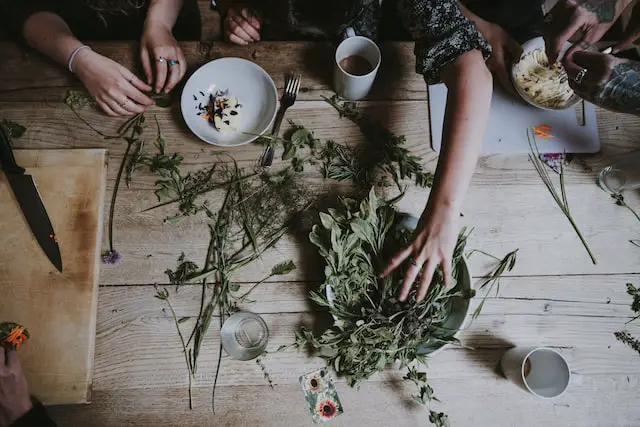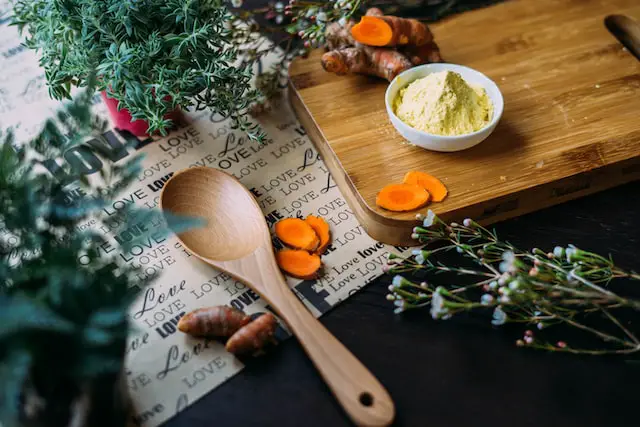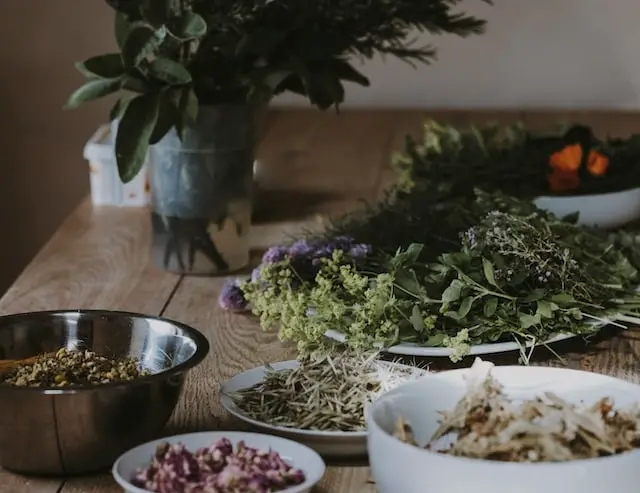Diane Brownlee and Jerry Smith recently acquired a 100-acre farm, and the future farm-steaders are eager to explore their cultivation options, including the approximately 150 herbs that can be found in Arkansas gardens.
The Little Rock residents are ready to get started, so they turned to the expert herbalist and gardener Debbie Tripp of Royal for advice at the recent urban homesteading conference at St. Joseph Center in North Little Rock. Like vine-ripened tomatoes or cucumbers, Tripp said, “There is a big difference between fresh herbs and the dried ones from the grocery stores. People find that they love fresh herbs.”
Tripp suggests, “If you’re a beginner, you might want to start with one or two easy herbs.” These could include mint or parsley in a pot or the garden. Fresh parsley or thyme is great with pasta, and, Tripp said, parsley is easy to dry and use through the winter months.

She offered a few words of caution about mint. When planting it, Tripp said it’s best to grow it in a container because it will quickly take over any garden. On the other hand, she said, it’s exciting to explore the many mint varieties like peppermint, lemon, pineapple, chocolate and more.
Grow your passion
“Plant what you like and what you will use. If you enjoy cooking, fresh herbs are a welcome addition to the kitchen,” and, she added, “Many of the Mediterranean herbs thrive in Arkansas.” Rosemary, for example, is easily grown in Central Arkansas, and once established, it will live several years with minimal care. “Rosemary can be infused in oils or used on top of baking bread,” she said. It can also be used as part of an herb blend that adds flavor to homemade products like goat’s cheese.
While basil is known as a key ingredient in pesto, a fresh leaf or two puts a different twist on a gin fizz. Another summer favorite, she said, is lemon grass, which can be used in salads or Asian soups. Neither basil nor lemon grass are winter hardy in our climate.
When asked what herbs are well-suited to Arkansas’ hot summers, Tripp rattled off a long list of herbs, including many well-known cooking herbs such as sage, thyme, oregano, chives, dill and parsley, and ones less known, like the aromatic tarragon, Texas tarragon, lavender and sorrel.
If herbs are to be used “as a fragrance in essential oils or candles,” she suggested lavender or lemon balm. Dried lavender can also be used to add a nice scent to clothes drawers or aid in a good night’s sleep.
Grow your garden
Whether a raised bed in the backyard, a sunny spot on a small patio or a vertical garden in your apartment, almost any space can used to grow herbs, and getting started can be done on the cheap. A 3-inch pot of parsley is usually less than $5 at a local store, while some herbs, such as mint or rosemary, can be started with a sprig or two from a friend’s garden.
Tripp advised starting small and acquiring additional plants over time so not to be overwhelmed. Still, she said, “Don’t be afraid to try something different.”
Herbs are like other plants and require a variety of growing conditions, so, she said, “Do your homework.” Getting started is the hard part of herb gardening, but in reality, herbs are not exotic or difficult to grow, Tripp said.

The rosemary thrives in Central Arkansas and is winter hardy. Fresh parsley is a tasty addition to pasta and is easily dried for winter use. It grows well in Arkansas in pots or in the ground. Even an old bathtub with proper drainage makes an interesting and fun herb container. It’s also part of the St. Joseph Center’s garden.
Let Your Herb Garden Reflect Your Personality And Your Needs, Said Herb Specialist Debbie Tripp. This Container Is Part Of The Herb Garden At The St. Joseph Center In North Little Rock.
Reflect yourself
“Regardless of the space you have available, let your herb garden be an expression of your personality… Containers can be as fun as the harvest,” Tripp said. Almost anything that holds dirt can be used, such as an old wooden barrel, a claw-foot bathtub or a new colorful container.
Down and dirty
One rule is paramount, Tripp said, most herbs don’t like “wet feet.” So while that pot at the retail shop may be the perfect look for your patio, don’t be tempted to buy it unless it has a hole or two at the bottom. Holes allow the excess water to drain instead of remaining trapped in the pot. Poor drainage or over-watering causes roots soften and decay, resulting in root rot.
Light is paramount to success
Each herb has different light requirements. Some prefer at least six hours of sunlight, while others do better with less. For indoor gardening, herbs need south or west facing windows, but if that’s not doable, consider using a florescent or full-spectrum grow light.

Debbie Tripp, herbalist and Rosemary Hill Herb Farm owner, was a speaker at the 2017 Arkansas Urban Homesteading Conference held at the St. Joseph Center in North Little Rock last November. Through practical and informative demonstrations, the conference was designed to share ideas and introduce farm life to city folks, including Tripp’s lecture titled “Herbs.”
Additional Resources
There’s plenty of information online about growing herbs and their uses, but be sure to cross reference information, especially when it comes to using herbs for medicinal purposes. For more ideas, Tripp urged conference attendees to attend seminars, network and learn from others. She also recommended Anne Kennedy’s book, “Herbal Medicine,” and Lucinda Hutson’s book, “The Herb Garden Cookbook.”
